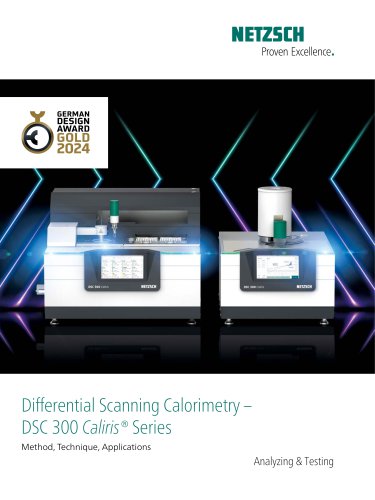 Website:
NETZSCH Analyzing & Testing
Website:
NETZSCH Analyzing & Testing
Group: NETZSCH
Catalog excerpts

Proven Excellence. Thermal Characterization of Polymers Thermoplastics, Thermoplastic Elastomers, Elastomers and Thermosets Analyzing & Testing
Open the catalog to page 1
The World of Polymers Polymer materials have greatly changed the world we live in – without them, the world would not be as we know it today. There is something innately fascinating about them, yet we've become accustomed to their integral presence in our everyday lives. And today, the possibility of recycling them makes them even more interesting from an ecological and economical point of view. Henri Braconnot’s work in the 1830s is perhaps the first modern example of polymer science. He, along with others, developed derivatives of the natural polymer cellulose, producing new,...
Open the catalog to page 2
During their production, processing and application, polymers are subjected to temperature-dependent structural changes. Therefore, thermal analysis for characterization of polymers is widely practiced today in research and industry. More and more applications are being backed up by national and international standards (ISO, EN, ASTM, DIN, etc.). Thermal analysis techniques give insight into the thermal properties of polymer materials and products and gain information regarding the condition or processing history of specific samples relative to reference samples. This makes thermal analysis...
Open the catalog to page 3
Differential Scanning Calorimetry (DSC) is the most frequently employed thermal analysis method. It can be used to analyze nearly any energetic effect occurring in a solid or liquid during thermal treatment. DSC analysis in accordance with ISO 1 1357 provides the following valuable information for the development and quality control of polymers: Product Identification and Characterization ■ Melting/crystallization temperatures ■ Melting/crystallization enthalpies ■ Cross-linking temperatures ■ Cross-linking enthalpies ■ Degree of crystallinity ■ Glass transition temperatures ■ Specific heat...
Open the catalog to page 4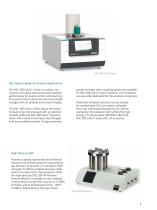
DSC Systems Made for Polymer Applications The DSC 214 Polyma features high heating and cooling rates, making it useful for both research and quality assurance in production. In complement to this, the DSC 204 F1 Phoenix® features a modular sensor design (τ- and μ-sensor), a large automatic sample changer and the ability to be coupled. Thermally activated reactions can be studied by conventional DSC, but cationic polyadditions and radical polymerizations can also be started by UV irradiation with sufficiently high energy. For this purpose, NETZSCH offers the Photo-DSC 204 F1 Phoenix®. The...
Open the catalog to page 5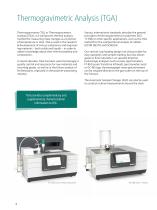
Thermogravimetric Analysis (TGA) Thermogravimetry (TG), or Thermogravimetric Analysis (TGA), is a well proven thermal analysis method for measuring mass changes as a function of temperature or time. TGA is used in the research & development of various substances and engineering materials – both solids and liquids – in order to obtain knowledge about their thermal stability and composition. In recent decades, TGA has been used increasingly in quality control and assurance for raw materials and incoming goods, as well as in the failure analysis of finished parts, especially in the...
Open the catalog to page 6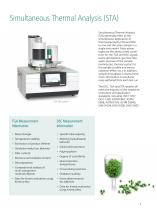
Simultaneous Thermal Analysis (STA) generally refers to the simultaneous application of thermogravimetry (TG) and DSC to one and the same sample in a single instrument. Main advantages are the identical test conditions for the TGA and DSC signals (same atmosphere, gas flow rate, vapor pressure of the sample, heating rate, thermal contact to the sample crucible and sensor, radiation effect, etc.). In addition, sample throughput is improved as more information is simultaneously gathered from each test run. The DSC, TGA and STA systems all meet the majority of the respective instrument and...
Open the catalog to page 7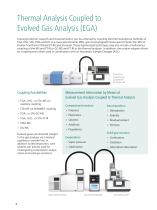
Thermal Analysis Coupled to Evolved Gas Analysis (EGA) Top-level polymer research and characterization can be achieved by coupling the thermoanalytical methods of TGA, DSC, STA, TMA and DIL to a mass spectrometer (MS), gas chromatograph/mass spectrometer (GC-MS) or Fourier Transform Infrared (FT-IR) spectrometer. These hyphenated techniques may also include simultaneous coupling of the MS and FT-IR or GC-MS and FT-IR to the thermal analyzer. In addition, the unique adapter allows for coupling even when used in combination with an Automatic Sample Changer (ASC). TGA-FT-IR coupling via an...
Open the catalog to page 8
Thermomechanical Analysis (TMA)/ Dilatometry (DIL) Thermomechanical analysis (TMA) and dilatometry (DIL) are two of the most important characterization techniques in the field of thermal analysis. DIL determines the length change of samples under a negligible load (DIN 51045). The closely related TMA method also determines the dimensional changes of solids, liquids or pasty materials as a function of temperature and/or time under a defined static load (ISO 11359, DIN 51 005, ASTM E831, ASTM D696, ASTM D3386). With the TMA 402 F1 Hyperion®, measuremens can additionally be carried out under...
Open the catalog to page 9
Dynamic Mechanical Analysis (DMA) Dynamic Mechanical Analysis (DMA) allows for the quantitative determination of the mechanical properties of a sample under an oscillating force and as a function of temperature, time, frequency and strain (DIN 53513, DIN EN ISO 6721, DIN 53440, DIN-IEC 1006, ASTM D4065, ASTM D4092, ASTM D4473, ASTM D5023, ASTM D5024, ASTM D5026, ASTM D5418). The results portray the linear viscoelastic properties, typically depicting them as a graphical plot of E’ (storage modulus), E” (loss modulus), and tanδ (loss factor) versus temperature. The DMA 242 E Artemis and the...
Open the catalog to page 10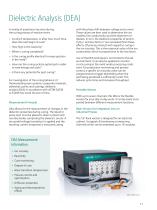
A variety of questions may arise during the curing process of reactive resins. ■ At which temperature, or after how much time, does the resin begin to cure? ■ How high is the reactivity? ■ When is curing completed? ■ Is the curing profile identical for every position in the mold? ■ How can the curing cycle be optimized in order to save energy and costs? ■ Is there any potential for post-curing? For investigation of the curing behavior of thermosetting resin systems, composite materials, adhesives, paints and coatings, dielectric analysis (DEA) in accordance with ASTM E2038 or E2039 has...
Open the catalog to page 11All NETZSCH Analyzing & Testing catalogs and technical brochures
-
TG 309 Libra Series
24 Pages
-
STA 449 F5 Jupiter®
16 Pages
-
DMA 303 Eplexor
24 Pages
-
ARC® 244 ARC® 254
1 Pages
-
HMOR 422
1 Pages
-
RUL/CIC 421
1 Pages
-
Product Overview
12 Pages
-
Kinexus Prime DSR Series
20 Pages
-
DIL 402 Expedis Select/Supreme
28 Pages
-
Rosand Series
20 Pages
-
Kinexus Prime Series
20 Pages
-
Advanced Materials Testing
32 Pages
-
NTA Fire Testing Systems
20 Pages
-
NTA Guarded Hot Plate Series
16 Pages
-
Cone Calorimeter TCC 918
12 Pages
-
Photo-DSC 204 F1 Phoenix®
8 Pages
-
TMA 402 F1/F3 Hyperion®
16 Pages
-
NTA HotBoxes Test Chambers
16 Pages
-
Thermal Insulation Materials
24 Pages
-
TA-QMS Coupling
16 Pages
-
STA 2500 Regulus
12 Pages
-
SBA 458 Nemesis®
24 Pages
-
NTA HotBoxes
16 Pages
-
NETZSCH NEVIO Instrument Series
24 Pages
-
LFA 467 HyperFlash® Series
28 Pages
-
LFA 427 - product brochure
24 Pages
-
Kinetics NEO
16 Pages
-
TG-FTIR - product brochure
24 Pages
-
DMA GABO EPLEXOR up to 1500°C
12 Pages
-
DMA GABO DiPLEXOR
8 Pages
-
DIL 402 Expedis Classic
16 Pages
-
DEA 288 Ionic
20 Pages
-
Accelerating Rate Calorimetry
20 Pages
-
GABO DiPLEXOR®
8 Pages
-
GABOMETER®
8 Pages










